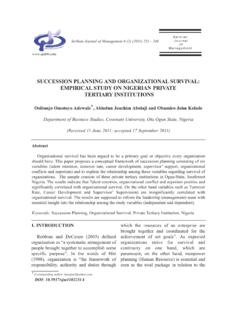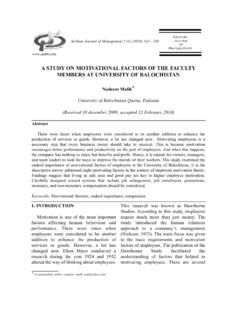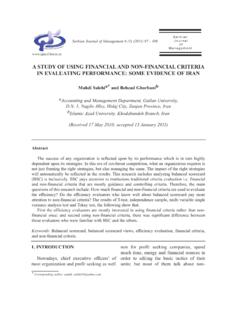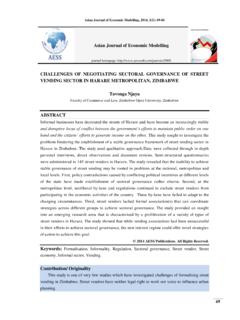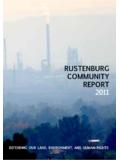Transcription of www.sjm06.com Letter to Editor NON-GOVERNMENT ...
1 1. INTRODUCTIONNon-Government Organizations (NGOs)have become an irresistible global forcetoday. The non-governmental sector, alsoknown as voluntary sector, is growing inrelation to its presence in developmentalactivities. Its role in the sphere of humandevelopment is now widely recognized andaccepted in most parts of the , an NGO or voluntaryorganisations are non-profit makingagencies that are constituted with a vision bya group of like minded people, committed forNON-GOVERNMENT ORGANIZATIONS.
2 PROBLEMS & REMEDIES IN INDIAK akumani Lavanya Lathaa*and Kotte PrabhakarbaDepartment of Management Studies, School of Management, Pondicherry UniversityPuducherry, IndiabDepartment of Anthropology, Sri Venkateswara University, Tirupati 517 502, Andhra Pradesh. India(Received 14. September 2009; accepted 10 August 2010)AbstractNGO are non-profit making agencies that are constituted with a vision by a group of like mindedpeople, committed for the uplift of the poor, marginalized, unprivileged, underprivileged,impoverished, downtrodden and the needy and they are closer and accessible to the target groups.
3 Фlexible in administration, quicker in decision making, timely in action and facilitating the peopletowards self-reliance ensuring their fullest participation in the whole process of development. Theachievements and success of NGOs in various fields and the excellent work done by them in specificareas is no doubt a tremendous task that has helped to meet the changing needs of the social , insprite of its achievements in various fields, NGOs are facing different problems whichdiffer from organization to organization, region to region.
4 In this context, an attempt is made in thispaper to discuss some of the common problems faced by the NGOs and to give some remedies toovercome these : NON-GOVERNMENT Organization, People, Programmes, Government and Problems.*Corresponding author: Journalof ManagementSerbian Journal of Management 6 (1) (2011) 109 - 121 to Editorthe uplift of the poor, marginalized,unprivileged, underprivileged,impoverished, downtrodden and the needyand they are closer and accessible to thetarget groups, flexible in administration,quicker in decision making, timely in actionand facilitating the people towards self-reliance ensuring their fullest participation inthe whole process of rapid growth of NGOs has beenclearly revealed in a major multi-nationstudy conducted recently by Lester Salamon.
5 Who finds it as a major economic and socialforce. He remarks that the global rise of thenon-profit sector may be as important adevelopment of the latter twentieth centuryas the development of the nation-state was inthe nineteenth century. A surprisingly largescale of non-profit activity was found inalmost every place the study team looked forthe study. The study, covering countries likeFrance, Germany, Hungary, Italy, Japan, theUK, the US, Brazil, Ghana, India andsupports the view that the sector isundoubtedly making fast strides in manyspheres of human activity.
6 The sector, as thestudy shows, has turned out to be a bigemployer offering employment to sevenmillion people in the US, million inJapan, nearly one million in France,Germany and the UK combined. It forms anaverage of percent of these countries totalwork forces employing one in every 11workers holding service jobs. It is also foundthat the sector is spending huge sums varyingfrom percent of the GDP in Hungary percent in the US with an average of Apparently, the growth of the voluntarysector has been phenomenal particularduring the last two decades.
7 The presence ofthe NGOs, especially those engaged indevelopmental efforts, has been strongly feltduring these years. In fact, the involvementof NGOs in development has becomeindispensable today. It is estimated thatabout 10 percent -$ eight billion-publicdevelopment aid world-wide is now beingrouted through Indian situation has not been,however, different. It the proliferation ofNGOs is of any indication, the sector isexpanding day to day. As per oneconservative estimate, the total number ofNGOs is over million.
8 This figureexcludes organizations like trade unions,schools and hospital but includes only thoseregistered for certification for receivingforeign assistance. The magnitude of fundsthe NGOs in the country handle today isanother index to this growth. The annualbudgets of these organizations are now not aparty sum but ranges from Rs. 30 million to5000 , the NGOs in the country assume aconspicuous role in multifariousdevelopmental programmes and achievements and success of NGOs invarious fields and the excellent work done bythem in specific areas is no doubt atremendous task that has helped to meet thechanging needs of the social , insprite of its achievements invarious fields, NGOs are facing differentproblems which differ from organization toorganization, region to region.
9 In thiscontext, an attempt is made in this paper todiscuss some of the common problems facedby the NGOs and to give some remedies toovercome these NGOs IN INDIANGOs or Voluntary Organizations are nota new phenomenon and the concept of110K. L. Latha / SJM 6 (1) (2011) 109 - 121voluntary action is very ancient. Accordingto Inamdar, During ancient and medievaltimes, voluntarism operated freely andexclusively in the fields of education,medicine, cultural promotion and even actedas succour in crises like droughts, floods,epidemics and foreign invasions (1987).
10 In the early years of 19th century,voluntary agencies provided services to theunder-privileged and weaker sections of thesociety. The areas of operation were largelyin the fields of religion and social Rammohan Roy (1772 -1833), IshwarChandra Vidyasagar (1820-1891), Sasi PadaBanarjee (1842-1925), Keshab Chandra Sen(1838-1884), Swami Dayanand Saraswati(1824-1883), Swami Vivekanand (1863-1902), Mahatma phule (1827-1888), PanditRamabai (1858-1922), Maharshi Karve(1858-1962), Sir Sayyed Ahmed Khan(1817-1898), Behramji Malbari (1853-1912)

